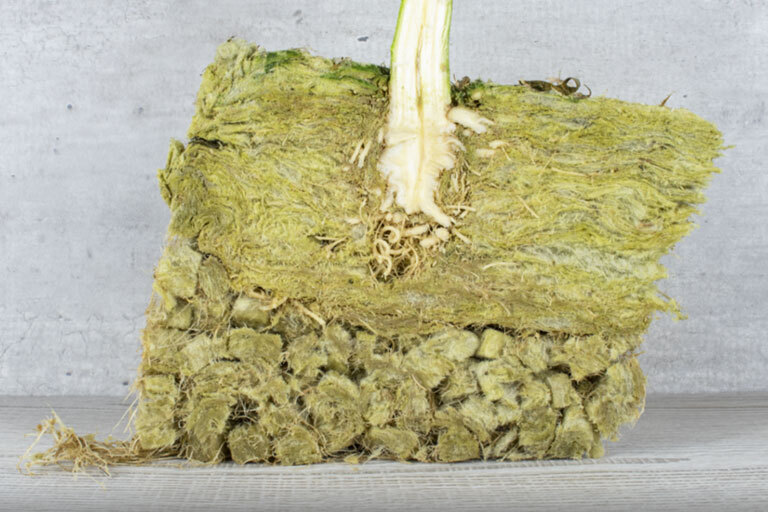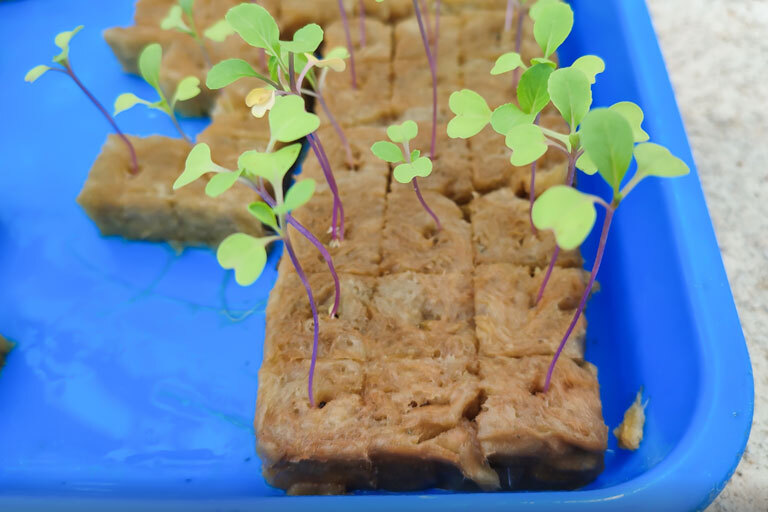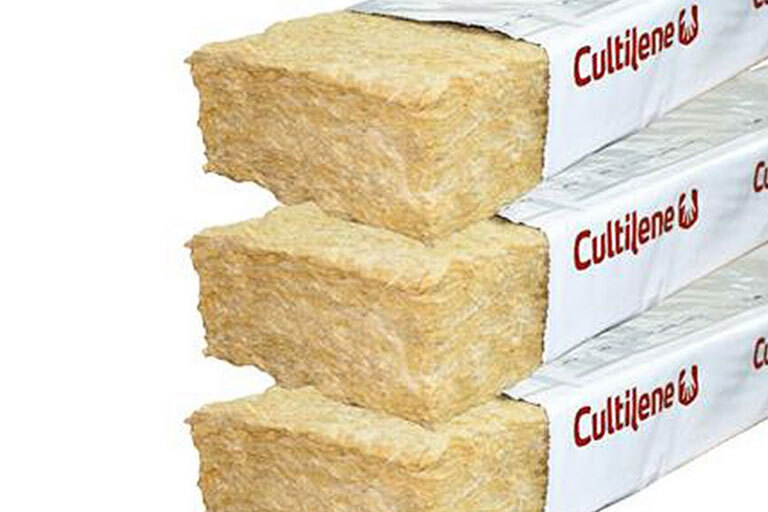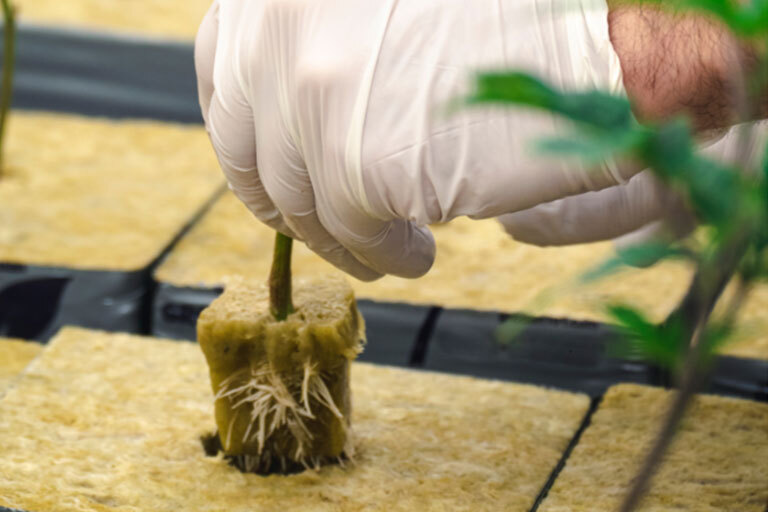Impossible to Overwater Rockwool Pwr Feed
Growing plants in Rockwool is a great idea. Rockwool is a lightweight hydroponic growing substrate. It is made from spinning molten, crushed basaltic rock into fine fibres. The final product is a dense mass of fine, intertwined fibres.
The density inside the Rockwool gives it excellent moisture-retention and aeration properties. The unique moisture gradient from top to the base gives your plant access to the nutrient solution and oxygen. Growing plants in Rockwool has many benefits, and is very flexible between systems.

Growing plants in Rockwool is a common growing method, widely used in commercial horticulture for the production of crops. Professional growers use Rockwool to grow plants like: tomatoes, melons, cucumbers, peppers, strawberries, herbs and cut flowers. Hobbyist hydroponic growers use Rockwool to take advantage of the improved root zone features of Rockwool.
Rockwool products are produced for different applications. Rockwool is available as: cubes, blocks, growing slabs and other granular products.
Benefits of Growing Plants in Rockwool
Moisture Retention and Moisture Gradient
Rockwool is extremely moisture-retentive and drains well. Following irrigation and subsequent draining, a standard Rockwool product will contain roughly 15% air pore space and 5% Rockwool fibres. Plants in Rockwool can easily access water, even when dried out, with as low as 20-30% moisture content.
Great Aeration Properties
Rockwool has a unique natural moisture gradient between the top and bottom sides. It provides superb aeration properties, with a balance of water and air for your plant's root system. Growing plants in Rockwool allows them to access water and nutrients and obtain plenty of oxygen.
The base of the Rockwool can fully saturate after watering. The upper layers of Rockwool are often drier, and well aerated, full of oxygen for root uptake and respiration.
Growing Plants in Rockwool is Versatile
Rockwool is available in slabs or cubes, in a variety of sizes. It breaks apart easily, if you need to make any adjustments. There are a variety of slightly different Rockwool products available that offer different benefits for different stages of plant growth.
Rockwool is Robust
Rockwool substrate won't degrade and break down through your grow cycle. It will remain strong and continue to efficiently retain water. This makes it ideal to use with hydroponic systems, as disintegrating materials can clog up pumps and filters, causing problems.
6 Top Tips For Growing Plants in Rockwool
1. Pre-Soak Your Rockwool
Before you place your plant in Rockwool, immerse the rockwool in a nutrient solution adjusted to pH 5.5 until it stops bubbling. Doing this allows the nutrient solution to infiltrate all the tiny pores in the Rockwool, ready for your plant to access.
The immersion time will vary depending on the size of the block or cube that you use. It could take a few seconds for tiny seed plugs to several minutes for the larger products. In some cases, professional growers drip moisture into larger blocks over 24+ hours.
Always let your Rockwool drain freely until there's no more water running out of it. This allows air to naturally fill the largest pores, helping to achieve the perfect balance between air and water in the medium.

2. Keep the Wrap On Rockwool Cubes
Most Rockwool products come wrapped in plastic foil. The foil's function is the same as the walls of a pot. It works to keep the light out and the roots in. It also helps to prevent the growth of algae, which although unpleasant to look at, is relatively harmless. On some Rockwool slabs, you will find that the wrap completely covers the product. This is to aid with the initial pre-soaking process.
Most slabs will not fit in buckets or tubs. The nutrient solution fills the wrap like a bag, until the slab saturates. After soaking, you should cut a drainage slit in the wrapping to allow the excess to drain away.

3. Allow for Sufficient Run-Off
Plants take up water at a higher rate than nutrients, so you should expect some increase in the concentration of fertiliser salts in the medium between watering. Plants don't absorb nutrients at the same rate. This can create nutrient imbalances and modify the nutrient solution's pH over time.
When you irrigate and achieve the recommended run-off rate, the water will push the remaining nutrients down and out of the Rockwool, and replace them with fresh nutrients. If you prevent the Rockwool from draining sufficiently, the unused nutrients will build up in the medium. Too many nutrient salts, built-up in the media can be bad for your plants.
4. Do Not Overwater Rockwool
You should allow for 15-30% run off after every feed in order to maintain optimal nutritional conditions in the root zone. Any more than this and you are at risk of over watering which can lead to algae growth.
Rockwool can achieve a very dry condition before the plant finds itself becoming dehydrated. The plant could actually tip over because the block is too light before you need to water again.
5. Rockwool Has a Moisture Gradient!
The natural moisture gradient of Rockwool is important. It's what makes it a great substrate. It allows it to saturate at the bottom and provide access to air pockets towards the top of the slab/cube. Those unfamiliar with this feature can make the mistake of thinking the Rockwool is too dry on the surface, so can tend to overwater it.
Don't saturate Rockwool from top to bottom, like a sponge. To get it right, you should allow the Rockwool to completely drain excess nutrient solution. As the nutrient drains away under gravity, fresh oxygen-laden air draws into the top layers, providing roots with fresh oxygen.

6. Reuse Your Rockwool
You can reuse Rockwool or shred and compost it. It is made from crushed Basalt. Basalt is a rock. Crushed rock makes for a brilliant addition to any potting mix. Do not reuse Rockwool to start plants, or repeatedly grow the same crops in rotation.
If you have issues with old roots remaining within the Rockwool, try treating them with an enzyme solution, such as GrowDog Exotic Enzymes, which works to break down old roots.
blanchardhomplever.blogspot.com
Source: https://www.futuregarden.co.uk/expert-advice/six-top-tip-for-growing-plants-in-rockwool/
Posting Komentar untuk "Impossible to Overwater Rockwool Pwr Feed"